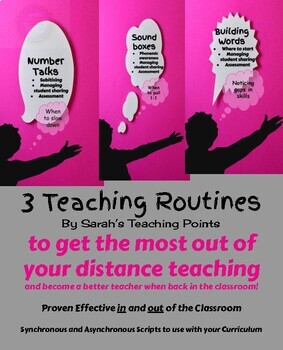FREE 3 Scripts for Minilessons or Distance Teaching Routines
- PDF
Description
Most Bang for your Buck (or for your time, as this is FREEEEEEE!)
Download '3 Teaching Routines' by Sarah’s Teaching Points to get the most out of your distance teaching and become a better teacher when back in the classroom! Our time is even more precious with students in these snippets of teachable moments. I believe in these routines for teaching and learning so much that I've scripted out a K-first grade lesson in each one for you to use and adapt daily. I've used these lessons K-5 and with special education and EL students. If I only had 5 minutes each day to set up foundational skills in math and reading, these are the non-negotiables.
Enjoy!
These routines are proven effective in and out of the classroom for decades!
- Number Talks
- Sound Boxes (phonemes)
- Building Words(phonics)
**Synchronous (face to face or video chat) and Asynchronous (learning management system videos) Scripts to use with any Curriculum sequence!!!





